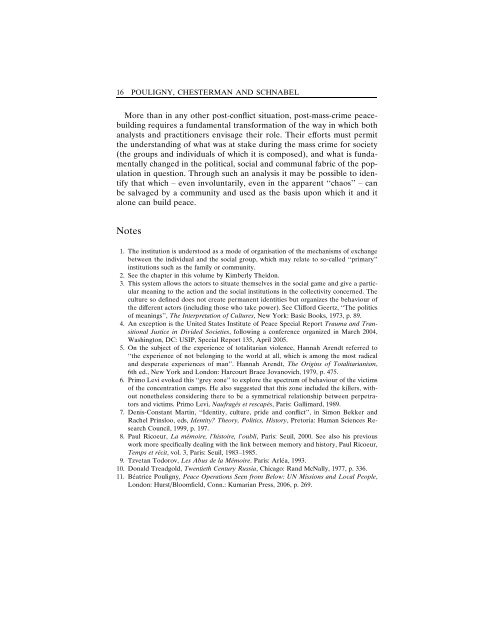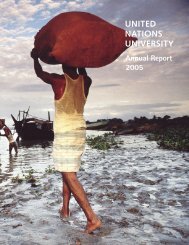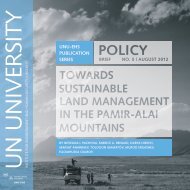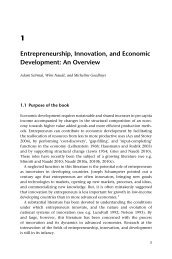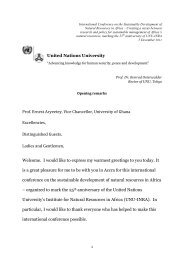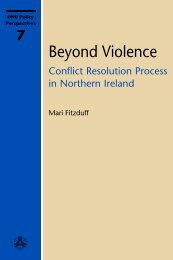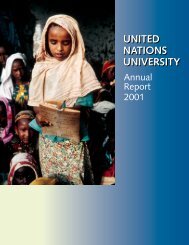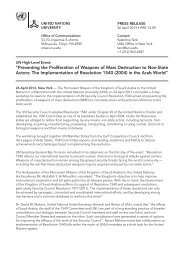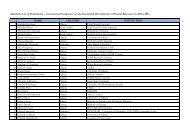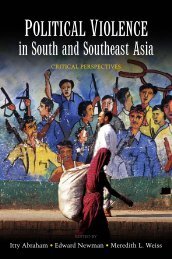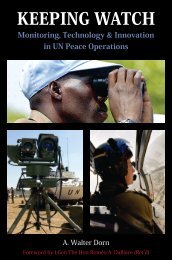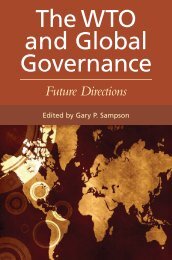After mass crime: Rebuilding states and communities
After mass crime: Rebuilding states and communities
After mass crime: Rebuilding states and communities
Create successful ePaper yourself
Turn your PDF publications into a flip-book with our unique Google optimized e-Paper software.
16 POULIGNY, CHESTERMAN AND SCHNABELMore than in any other post-conflict situation, post-<strong>mass</strong>-<strong>crime</strong> peacebuildingrequires a fundamental transformation of the way in which bothanalysts <strong>and</strong> practitioners envisage their role. Their efforts must permitthe underst<strong>and</strong>ing of what was at stake during the <strong>mass</strong> <strong>crime</strong> for society(the groups <strong>and</strong> individuals of which it is composed), <strong>and</strong> what is fundamentallychanged in the political, social <strong>and</strong> communal fabric of the populationin question. Through such an analysis it may be possible to identifythat which – even involuntarily, even in the apparent ‘‘chaos’’ – canbe salvaged by a community <strong>and</strong> used as the basis upon which it <strong>and</strong> italone can build peace.Notes1. The institution is understood as a mode of organisation of the mechanisms of exchangebetween the individual <strong>and</strong> the social group, which may relate to so-called ‘‘primary’’institutions such as the family or community.2. See the chapter in this volume by Kimberly Theidon.3. This system allows the actors to situate themselves in the social game <strong>and</strong> give a particularmeaning to the action <strong>and</strong> the social institutions in the collectivity concerned. Theculture so defined does not create permanent identities but organizes the behaviour ofthe different actors (including those who take power). See Clifford Geertz, ‘‘The politicsof meanings’’, The Interpretation of Cultures, New York: Basic Books, 1973, p. 89.4. An exception is the United States Institute of Peace Special Report Trauma <strong>and</strong> TransitionalJustice in Divided Societies, following a conference organized in March 2004,Washington, DC: USIP, Special Report 135, April 2005.5. On the subject of the experience of totalitarian violence, Hannah Arendt referred to‘‘the experience of not belonging to the world at all, which is among the most radical<strong>and</strong> desperate experiences of man’’. Hannah Arendt, The Origins of Totalitarianism,6th ed., New York <strong>and</strong> London: Harcourt Brace Jovanovich, 1979, p. 475.6. Primo Levi evoked this ‘‘grey zone’’ to explore the spectrum of behaviour of the victimsof the concentration camps. He also suggested that this zone included the killers, withoutnonetheless considering there to be a symmetrical relationship between perpetrators<strong>and</strong> victims. Primo Levi, Naufragés etrescapés, Paris: Gallimard, 1989.7. Denis-Constant Martin, ‘‘Identity, culture, pride <strong>and</strong> conflict’’, in Simon Bekker <strong>and</strong>Rachel Prinsloo, eds, Identity? Theory, Politics, History, Pretoria: Human Sciences ResearchCouncil, 1999, p. 197.8. Paul Ricoeur, La mémoire, l’histoire, l’oubli, Paris: Seuil, 2000. See also his previouswork more specifically dealing with the link between memory <strong>and</strong> history, Paul Ricoeur,Temps et récit, vol. 3, Paris: Seuil, 1983–1985.9. Tzvetan Todorov, LesAbusdelaMémoire. Paris: Arléa, 1993.10. Donald Treadgold, Twentieth Century Russia, Chicago: R<strong>and</strong> McNally, 1977, p. 336.11. Béatrice Pouligny, Peace Operations Seen from Below: UN Missions <strong>and</strong> Local People,London: Hurst/Bloomfield, Conn.: Kumarian Press, 2006, p. 269.


